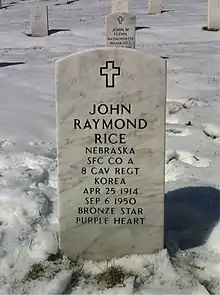John Raymond Rice
Sergeant First Class John Raymond Rice (Native American name: Walking in Blue Sky[1]) (April 25, 1914 – September 6, 1950) was a Ho Chunk (Winnebago) Indian and a United States Army soldier killed in action while leading his squad in Korea in 1950. A Sioux City, Iowa cemetery refused to bury his body because he was Native American, touching off a national episode culminating in President Harry Truman ordering his body to be interred in Arlington National Cemetery.
John Raymond Rice (Walking in Blue Sky) | |
|---|---|
 Grave at Arlington National Cemetery | |
| Born | April 25, 1914 Winnebago, Nebraska, US |
| Died | September 6, 1950 (aged 36) Tabu-Dong, Korea |
| Buried | |
| Allegiance | United States |
| Service/ | United States Marine Corps; United States Army |
| Rank | Sergeant First Class |
| Service number | 17033372 |
| Unit | Company A, 8th Cavalry Regiment, United States Army |
| Battles/wars | Battle of Tabu-Dong |
| Awards | Bronze Star, Purple Heart |
| Known for | Sioux City Memorial Park Cemetery refusing to bury his body because he was Native American |
Biography
A tribal member of the Ho-Chunk Nation, also known as the Winnebago Indian Tribe, Rice was born in Winnebago, Nebraska, and had previously served in the United States Marine Corps during World War II.[2] During World War II Rice was awarded the Bronze Star for heroism during the New Guinea campaign. In the Korean War he was killed leading a squad of Company A, 8th Cavalry Regiment, during the Battle of Tabu-dong "one of the most critical and heroic stands made by the hard-pressed United Nations forces."[3][4][5]
During his funeral on August 28, 1951—at the Memorial Park Cemetery in Sioux City, Iowa—a cemetery employee noticed there were Native Americans among the mourners. After the military burial service, including the ceremonial three-volley salute, cemetery officials discovered that Rice himself was Native American. They stopped the actual burial, and made his non-Indian wife Evelyn take his body away.[6] Prior to making burial arrangements at Memorial Park Cemetery, the widow had already been denied the burial of Rice at the city-owned cemeteries because of his race.
According to cemetery officials, "private cemeteries have always had a right to be operated for a particular group such as Jewish, Catholic, Lutheran, Negro, Chinese, etc., not because of any prejudice against any race, but because people, like animals, prefer to be with their own kind."[7]
The following day, August 29, then-President Harry Truman publicly reprimanded the cemetery and the Sioux City town leaders. Rice's wife was given a plot in Arlington National Cemetery.[8] The press and local groups in Sioux City also lambasted the Sioux City cemetery.
Sergeant Rice was buried on September 5, 1951, nearly a year to the day after he died, in Arlington National Cemetery.[9]
References
- "Soldier's Burial". Time Magazine. 1951-09-10. Archived from the original on November 23, 2010. Retrieved 2009-10-01.
- Way of the Warrior (2007) PBS documentary.
- Huston, Luther (May 10, 1955). "Burial Bias Plea Rejected Again". New York Times.
- "Truman Sets Arlington Interment For Indian Denied 'White' Burial". New York Times. August 30, 1951.
- "Indian Hero's Burial Set for Wednesday". New York Times. August 31, 1951.
- "Soldier's Burial". Time Magazine. 1951-09-10. Archived from the original on November 23, 2010. Retrieved 2009-10-01.
- "Sergeant John R. Rice". Notable People. SiouxCityHistory.org. Retrieved 2015-10-16.
- "Truman Acts After Indian Vet Denied Sioux City Burial". The Marion Star. 29 August 1951. p. 12. Retrieved 20 July 2017 – via newspapers.com.
- "Burial Detail: Rice, John Raymond (Section 34, Grave 1033-2) Birth Date: 04/25/1914, Death Date: 09/06/1950; Interment Date: 09/05/1951". ANC Explorer. Arlington National Cemetery. (Official website).
Further reading
- Richardson, Christian (May 6, 2006). "Slain hero, wife to be reunited at Arlington Cemetery". Sioux City Journal.
- Thompson, Kate (August 29, 2001). "Memorial honors Sgt. Rice, 50 years after his burial was refused". Sioux City Journal.
External links
- Sergeant John R. Rice in "Notable People" on Sioux City History